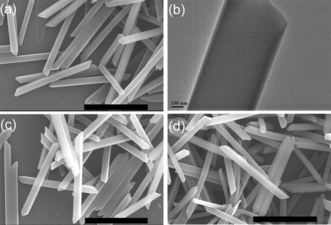We report the first highly efficient artificial light-harvesting systems based on nanocrystals of difluoroboron chromophores to mimic the chlorosomes, one of the most efficient light-harvesting systems found in green photosynthetic bacteria. Uniform nanocrystals with controlled donor/acceptor ratios were prepared by simple coassembly of the donors and acceptors in water. The light-harvesting system funneled the excitation energy collected by a thousand donor chromophores to a single acceptor. The well-defined spatial organization of individual chromophores in the nanocrystals enabled an energy transfer efficiency of 95 %, even at a donor/acceptor ratio as high as 1000:1, and a significant fluorescence of the acceptor was observed up to donor/acceptor ratios of 200 000:1. Angewandte Chemie First published: 21 January 2016 
a) SEM and b) TEM images of as-prepared BF2bcz nanocrystals obtained by SDS-assisted reprecipitation at room temperature. c,d) SEM images of BF2bcz nanocrystals doped with 0.1 mol % BF2dan and BF2cna, respectively, prepared under the same conditions as that in (a). Scale bar in SEM images: 5 μm. |

